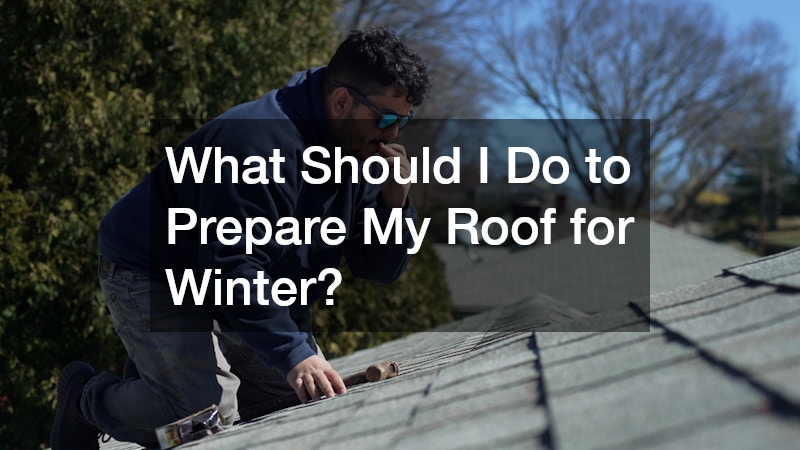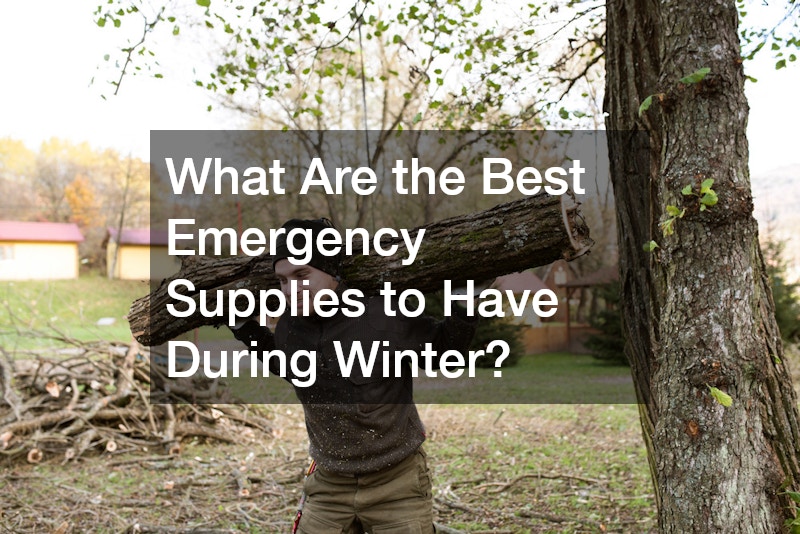As winter approaches, homeowners often face the challenge of ensuring their homes are fully prepared for harsh weather conditions. Winter-proofing your home is essential not only for comfort but also for safety and energy efficiency. The process involves a combination of smart planning, regular maintenance, and strategic upgrades, all aimed at reducing the impact of cold temperatures, snow, and ice. Consulting with professional contractors, such as a gutter company, local roofers, or a local tree service, can help identify vulnerabilities and implement solutions that will keep your home safe throughout the season.
Winter-proofing begins with understanding which areas of your property are most susceptible to damage. From roofs that bear heavy snow loads to plumbing that risks freezing in low temperatures, every aspect of your home can benefit from expert attention. Homeowners may also overlook exterior features, such as vinyl fencing or hardscaping, which require proper care to withstand icy conditions. Additionally, tasks like facade restoration, gutter cleaning, and irrigation adjustments are critical for preventing long-term damage. By taking a proactive approach, homeowners can save money on repairs, avoid energy loss, and maintain a comfortable living environment. This article explores practical, contractor-informed strategies to winter-proof your home efficiently and effectively.
- How Can I Improve Insulation in My Home?
- What Are the Best Ways to Seal Windows and Doors?
- How Often Should I Check My Heating System?
- What Should I Do to Prepare My Roof for Winter?
- How Can I Prevent Frozen Pipes?
- What Landscaping Tips Can Help with Winter Preparedness?
- How Can I Winterize My Outdoor Spaces?
- What Should I Check for in My Fireplace and Chimney?
- How Can I Ensure My Home Is Energy-Efficient During Winter?
- What Are the Best Emergency Supplies to Have During Winter?
How Can I Improve Insulation in My Home?

Types of Insulation Materials
Proper insulation is one of the most critical steps to winter-proof your home. Common materials include fiberglass batts, spray foam, cellulose, and rigid foam boards. Each type has its advantages; for instance, spray foam provides excellent air sealing, while cellulose is eco-friendly and effective in older homes. Local roofers or insulation specialists can assess your home and recommend materials that suit your specific structure and climate.
Areas to Focus on for Insulation
When winter-proofing, prioritizing areas like attics, basements, and exterior walls ensures maximum heat retention. Many homes lose a significant portion of their warmth through uninsulated spaces, so targeting these zones with professional guidance can improve energy efficiency. Hiring a reputable local roofer or contractor familiar with insulation can ensure proper installation and minimize gaps that could allow cold air to seep in.
Professional Insulation Installation vs. DIY
While some homeowners attempt DIY insulation, professional installation often guarantees better results. Contractors, including local roofers or a gutter company, can identify hidden leaks or structural issues that may compromise insulation. Professional techniques also reduce the risk of moisture buildup, which could lead to mold or rot, further enhancing the winter-proofing of your home.
What Are the Best Ways to Seal Windows and Doors?
Types of Caulk and Sealants
Sealing gaps around windows and doors is essential for winter-proofing. Silicone and acrylic latex caulks are commonly used for exterior applications, while weather-resistant sealants can address interior drafts. A local roofer or handyman specializing in winter preparation can guide homeowners on the most suitable products for their home’s unique needs.
Weather Stripping Options
Weather stripping provides a cost-effective solution to prevent air leaks. Options range from foam tape to door sweeps, each offering varying levels of insulation. Proper installation, sometimes requiring contractor expertise, ensures these measures are effective in keeping indoor spaces warm.
Identifying Drafts and Leaks
Detecting drafts is a key step in winter-proofing your home. Homeowners can use simple techniques, such as holding a candle near doors and windows to spot moving air, or consult a local roofer or insulation expert for a professional energy audit. Addressing these leaks improves both comfort and energy efficiency, ultimately reducing heating costs.
How Often Should I Check My Heating System?
Signs Your Heating System Needs Maintenance
Regularly checking your heating system is essential for winter-proofing. Common indicators of required maintenance include unusual noises, uneven heating, and rising energy bills. Local HVAC specialists or contractors can provide inspection services to ensure your system operates efficiently.
Benefits of Regular System Servicing
Routine servicing enhances system longevity, prevents breakdowns during cold spells, and maintains indoor air quality. Winter-proofing your home with a well-maintained heating system ensures reliable warmth and safety throughout the season.
What to Expect During a Tune-Up
Professional tune-ups typically include checking filters, inspecting ductwork, and testing thermostat functionality. Hiring a qualified contractor ensures thorough servicing and minimizes potential winter emergencies, making this a vital step in the winter-proofing process.
What Should I Do to Prepare My Roof for Winter?

Inspecting for Damage: What to Look For
Winter-proofing your roof starts with a comprehensive inspection. Look for missing shingles, cracked flashing, or signs of water damage. Local roofers and roofing contractors can provide expert evaluations and necessary repairs before snow or ice exacerbates existing issues.
Cleaning Gutters and Downspouts
A reliable gutter company can help clear leaves, debris, and blockages. Winter-proofing your home requires ensuring that gutters and downspouts are unobstructed to prevent ice dams and water infiltration, which can damage roofing, siding, and foundation areas.
The Importance of Ice Dams Prevention
Ice dams occur when heat escapes through the roof, melting snow that refreezes at the edges. This can lead to leaks and water damage. Winter-proofing strategies, such as proper insulation, attic ventilation, and professional roof inspection, are essential to prevent ice dam formation and protect your home’s structural integrity.
How Can I Prevent Frozen Pipes?
Insulating Pipes in Vulnerable Areas
Frozen pipes are a common winter hazard. Winter-proofing your plumbing system involves insulating pipes in basements, attics, garages, and other vulnerable areas. Professional contractors or local roofers familiar with seasonal preparation can recommend effective insulation materials.
Tips for Maintaining Heat in the Plumbing System
Keeping interior temperatures steady, allowing faucets to drip during extreme cold, and sealing openings near pipes all contribute to winter-proofing against freezes. Working with a plumbing contractor ensures these strategies are implemented correctly, reducing the risk of pipe bursts.
Emergency Solutions for Frozen Pipes
In case of frozen pipes, knowing how to safely thaw them is critical. Contractors can provide guidance on using heat lamps or warm towels and advise on shutting off water quickly to minimize damage. Winter-proofing involves both preventative and responsive measures for plumbing protection.
What Landscaping Tips Can Help with Winter Preparedness?
Protecting Trees and Shrubs
A local tree service can help winter-proof your landscaping by pruning weak branches and wrapping sensitive trees and shrubs. This protects your property from damage caused by snow, ice, and heavy winds. Additionally, applying anti-desiccant sprays or burlap wraps can shield plants from cold, drying winter air.
Mulching and Soil Care
Proper mulching insulates roots and prevents soil from freezing too rapidly. Winter-proofing your yard ensures that plants survive harsh conditions and resume healthy growth in spring. Local tree services or landscaping contractors can offer expertise in mulching techniques and soil protection. Adding a layer of compost or organic matter can further enrich the soil and support plant health through winter.
Planning for Snow Management
Winter-proofing also involves preparing for snow removal. Hardscaping strategies, such as graded driveways and paths, along with irrigation adjustments, can facilitate snow management and prevent ice accumulation. Asphalt contractors or hardscaping professionals can advise on materials that remain durable under heavy snow. Strategically placing snow fences or barriers can also help reduce drifting and keep walkways and driveways safer.
How Can I Winterize My Outdoor Spaces?

Preparing Patios and Decks
Winter-proofing patios and decks involves cleaning surfaces, sealing wood, and repairing cracks. Exposure to snow and ice can cause rot or structural damage over time. A local roofer or hardscaping contractor can advise on sealants or protective coatings that extend the life of your outdoor spaces. Additionally, vinyl fencing near patios should be inspected for stability, ensuring panels remain secure during harsh weather.
Storing Outdoor Furniture
Winter-proofing your outdoor living areas also includes protecting furniture. Storing cushions, folding chairs, and tables indoors or in weatherproof covers prevents material deterioration. Contractors experienced in winter preparation, or local tree service professionals who understand yard layouts, can recommend optimal storage strategies for accessibility and protection.
Ensuring Outdoor Lighting Works Effectively
Maintaining outdoor lighting is a small but significant aspect of winter-proofing. Snow and ice can damage fixtures, so inspecting and replacing bulbs, checking wiring, and positioning lights to illuminate walkways reduces accidents and enhances safety. Local electricians or contractors can help ensure your outdoor lighting system is winter-ready.
What Should I Check for in My Fireplace and Chimney?
Importance of Cleaning and Inspection
Winter-proofing your home includes inspecting and cleaning your fireplace and chimney. Creosote buildup, blockages, or cracks can pose fire hazards. A professional chimney sweep or contractor ensures the system is safe and fully operational before heavy winter use. Regular inspections also help identify subtle structural issues early, preventing costly repairs later.
Understanding Chimney Safety and Codes
Fireplace and chimney safety codes vary by location. Local roofers or specialized contractors familiar with building regulations can help winter-proof your home by confirming compliance and recommending upgrades. Proper inspections prevent emergencies and maintain efficient heat output. Following these codes also reduces liability and ensures your fireplace operates safely throughout the winter season.
Alternatives to Traditional Fireplaces
For homeowners seeking winter-proofing alternatives, electric or gas fireplaces provide warmth without the maintenance challenges of wood-burning units. These options reduce soot, creosote buildup, and the risk of structural damage, complementing other winter-proofing measures like insulation and hardscaping preparation. Choosing these alternatives also allows for more flexible placement in the home, helping optimize heating efficiency and comfort.
How Can I Ensure My Home Is Energy-Efficient During Winter?
Using Programmable Thermostats
Programmable thermostats allow homeowners to control heating schedules efficiently. Winter-proofing your home with these devices minimizes energy waste while maintaining comfort. Professional contractors or local roofers can recommend models suitable for your HVAC system and integrate them seamlessly into your home.
Energy-Efficient Window Treatments
Installing insulated curtains, blinds, or window films contributes to winter-proofing by preventing heat loss. Local contractors, including those who specialize in facade restoration, can suggest energy-efficient materials that complement your home’s aesthetics while improving thermal retention.
Identifying Energy Waste Areas
A thorough home energy audit highlights areas of heat loss, from leaky windows to poorly insulated attics. Local roofers, a gutter company, or insulation experts can provide insights on winter-proofing strategies that reduce energy bills and maintain indoor comfort throughout cold months.
What Are the Best Emergency Supplies to Have During Winter?

Essential Supplies for Power Outages
Winter-proofing your home requires preparation for unexpected events. Essential supplies include flashlights, batteries, backup generators, and non-perishable food. A local roofer or contractor familiar with seasonal emergencies can advise on how to protect your property and maintain safety during outages.
Creating a Winter Emergency Kit
A comprehensive winter emergency kit should include warm clothing, blankets, first-aid materials, and tools for snow or ice removal. Winter-proofing ensures these items are accessible and ready for use in case of extreme weather. Local tree service companies and hardscaping contractors may also provide guidance on preventing outdoor hazards that could impact your emergency preparedness.
Preparing for Severe Weather Events
Beyond supplies, winter-proofing involves proactive measures, such as trimming overhanging branches with a local tree service, reinforcing vinyl fencing, and ensuring roofs and gutters are secure. Asphalt contractors can inspect driveways and walkways for safe winter access, while irrigation companies can winterize water lines to prevent freezing.
Winter-proofing your home is a multi-faceted process that combines safety, energy efficiency, and comfort. By following expert contractor advice and addressing both interior and exterior vulnerabilities, homeowners can minimize damage, reduce energy costs, and maintain a warm living environment during harsh winter months. Local roofers, a gutter company, asphalt contractors, and hardscaping professionals all play critical roles in preparing your home for seasonal challenges. Additionally, consulting with vinyl fencing experts, local tree service providers, and irrigation companies ensures that every element of your property is ready to withstand cold, ice, and snow.
Proactive steps like insulation upgrades, window sealing, pipe protection, and exterior maintenance form the foundation of effective winter-proofing. When combined with emergency preparedness measures—such as winter kits, backup supplies, and thoughtful landscaping strategies—these actions provide peace of mind and a safe haven for your family. Facade restoration, roof inspections, and outdoor space preparation are not just cosmetic measures; they are investments in long-term durability. By taking a systematic, contractor-informed approach, homeowners can confidently navigate winter while keeping their property secure, energy-efficient, and comfortable throughout the season.





